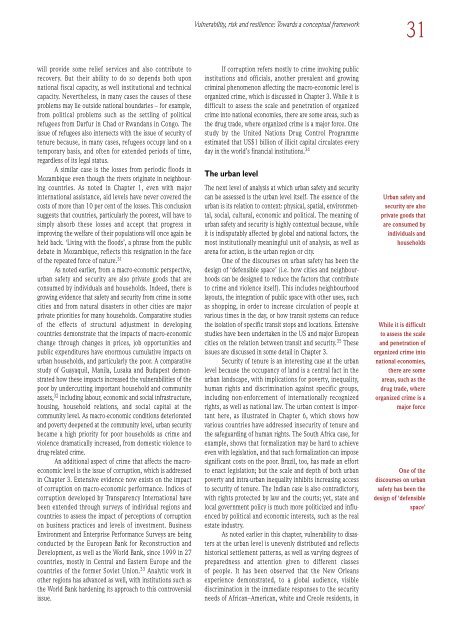Download the file - United Nations Rule of Law
Download the file - United Nations Rule of Law
Download the file - United Nations Rule of Law
- No tags were found...
Create successful ePaper yourself
Turn your PDF publications into a flip-book with our unique Google optimized e-Paper software.
Vulnerability, risk and resilience: Towards a conceptual framework31will provide some relief services and also contribute torecovery. But <strong>the</strong>ir ability to do so depends both uponnational fiscal capacity, as well institutional and technicalcapacity. Never<strong>the</strong>less, in many cases <strong>the</strong> causes <strong>of</strong> <strong>the</strong>seproblems may lie outside national boundaries – for example,from political problems such as <strong>the</strong> settling <strong>of</strong> politicalrefugees from Darfur in Chad or Rwandans in Congo. Theissue <strong>of</strong> refugees also intersects with <strong>the</strong> issue <strong>of</strong> security <strong>of</strong>tenure because, in many cases, refugees occupy land on atemporary basis, and <strong>of</strong>ten for extended periods <strong>of</strong> time,regardless <strong>of</strong> its legal status.A similar case is <strong>the</strong> losses from periodic floods inMozambique even though <strong>the</strong> rivers originate in neighbouringcountries. As noted in Chapter 1, even with majorinternational assistance, aid levels have never covered <strong>the</strong>costs <strong>of</strong> more than 10 per cent <strong>of</strong> <strong>the</strong> losses. This conclusionsuggests that countries, particularly <strong>the</strong> poorest, will have tosimply absorb <strong>the</strong>se losses and accept that progress inimproving <strong>the</strong> welfare <strong>of</strong> <strong>the</strong>ir populations will once again beheld back. ‘Living with <strong>the</strong> floods’, a phrase from <strong>the</strong> publicdebate in Mozambique, reflects this resignation in <strong>the</strong> face<strong>of</strong> <strong>the</strong> repeated force <strong>of</strong> nature. 31As noted earlier, from a macro-economic perspective,urban safety and security are also private goods that areconsumed by individuals and households. Indeed, <strong>the</strong>re isgrowing evidence that safety and security from crime in somecities and from natural disasters in o<strong>the</strong>r cities are majorprivate priorities for many households. Comparative studies<strong>of</strong> <strong>the</strong> effects <strong>of</strong> structural adjustment in developingcountries demonstrate that <strong>the</strong> impacts <strong>of</strong> macro-economicchange through changes in prices, job opportunities andpublic expenditures have enormous cumulative impacts onurban households, and particularly <strong>the</strong> poor. A comparativestudy <strong>of</strong> Guayaquil, Manila, Lusaka and Budapest demonstratedhow <strong>the</strong>se impacts increased <strong>the</strong> vulnerabilities <strong>of</strong> <strong>the</strong>poor by undercutting important household and communityassets, 32 including labour, economic and social infrastructure,housing, household relations, and social capital at <strong>the</strong>community level. As macro-economic conditions deterioratedand poverty deepened at <strong>the</strong> community level, urban securitybecame a high priority for poor households as crime andviolence dramatically increased, from domestic violence todrug-related crime.An additional aspect <strong>of</strong> crime that affects <strong>the</strong> macroeconomiclevel is <strong>the</strong> issue <strong>of</strong> corruption, which is addressedin Chapter 3. Extensive evidence now exists on <strong>the</strong> impact<strong>of</strong> corruption on macro-economic performance. Indices <strong>of</strong>corruption developed by Transparency International havebeen extended through surveys <strong>of</strong> individual regions andcountries to assess <strong>the</strong> impact <strong>of</strong> perceptions <strong>of</strong> corruptionon business practices and levels <strong>of</strong> investment. BusinessEnvironment and Enterprise Performance Surveys are beingconducted by <strong>the</strong> European Bank for Reconstruction andDevelopment, as well as <strong>the</strong> World Bank, since 1999 in 27countries, mostly in Central and Eastern Europe and <strong>the</strong>countries <strong>of</strong> <strong>the</strong> former Soviet Union. 33 Analytic work ino<strong>the</strong>r regions has advanced as well, with institutions such as<strong>the</strong> World Bank hardening its approach to this controversialissue.If corruption refers mostly to crime involving publicinstitutions and <strong>of</strong>ficials, ano<strong>the</strong>r prevalent and growingcriminal phenomenon affecting <strong>the</strong> macro-economic level isorganized crime, which is discussed in Chapter 3. While it isdifficult to assess <strong>the</strong> scale and penetration <strong>of</strong> organizedcrime into national economies, <strong>the</strong>re are some areas, such as<strong>the</strong> drug trade, where organized crime is a major force. Onestudy by <strong>the</strong> <strong>United</strong> <strong>Nations</strong> Drug Control Programmeestimated that US$1 billion <strong>of</strong> illicit capital circulates everyday in <strong>the</strong> world’s financial institutions. 34The urban levelThe next level <strong>of</strong> analysis at which urban safety and securitycan be assessed is <strong>the</strong> urban level itself. The essence <strong>of</strong> <strong>the</strong>urban is its relation to context: physical, spatial, environmental,social, cultural, economic and political. The meaning <strong>of</strong>urban safety and security is highly contextual because, whileit is indisputably affected by global and national factors, <strong>the</strong>most institutionally meaningful unit <strong>of</strong> analysis, as well asarena for action, is <strong>the</strong> urban region or city.One <strong>of</strong> <strong>the</strong> discourses on urban safety has been <strong>the</strong>design <strong>of</strong> ‘defensible space’ (i.e. how cities and neighbourhoodscan be designed to reduce <strong>the</strong> factors that contributeto crime and violence itself). This includes neighbourhoodlayouts, <strong>the</strong> integration <strong>of</strong> public space with o<strong>the</strong>r uses, suchas shopping, in order to increase circulation <strong>of</strong> people atvarious times in <strong>the</strong> day, or how transit systems can reduce<strong>the</strong> isolation <strong>of</strong> specific transit stops and locations. Extensivestudies have been undertaken in <strong>the</strong> US and major Europeancities on <strong>the</strong> relation between transit and security. 35 Theseissues are discussed in some detail in Chapter 3.Security <strong>of</strong> tenure is an interesting case at <strong>the</strong> urbanlevel because <strong>the</strong> occupancy <strong>of</strong> land is a central fact in <strong>the</strong>urban landscape, with implications for poverty, inequality,human rights and discrimination against specific groups,including non-enforcement <strong>of</strong> internationally recognizedrights, as well as national law. The urban context is importan<strong>the</strong>re, as illustrated in Chapter 6, which shows howvarious countries have addressed insecurity <strong>of</strong> tenure and<strong>the</strong> safeguarding <strong>of</strong> human rights. The South Africa case, forexample, shows that formalization may be hard to achieveeven with legislation, and that such formalization can imposesignificant costs on <strong>the</strong> poor. Brazil, too, has made an effortto enact legislation; but <strong>the</strong> scale and depth <strong>of</strong> both urbanpoverty and intra-urban inequality inhibits increasing accessto security <strong>of</strong> tenure. The Indian case is also contradictory,with rights protected by law and <strong>the</strong> courts; yet, state andlocal government policy is much more politicized and influencedby political and economic interests, such as <strong>the</strong> realestate industry.As noted earlier in this chapter, vulnerability to disastersat <strong>the</strong> urban level is unevenly distributed and reflectshistorical settlement patterns, as well as varying degrees <strong>of</strong>preparedness and attention given to different classes<strong>of</strong> people. It has been observed that <strong>the</strong> New Orleansexperience demonstrated, to a global audience, visiblediscrimination in <strong>the</strong> immediate responses to <strong>the</strong> securityneeds <strong>of</strong> African–American, white and Creole residents, inUrban safety andsecurity are alsoprivate goods thatare consumed byindividuals andhouseholdsWhile it is difficultto assess <strong>the</strong> scaleand penetration <strong>of</strong>organized crime intonational economies,<strong>the</strong>re are someareas, such as <strong>the</strong>drug trade, whereorganized crime is amajor forceOne <strong>of</strong> <strong>the</strong>discourses on urbansafety has been <strong>the</strong>design <strong>of</strong> ‘defensiblespace’
















